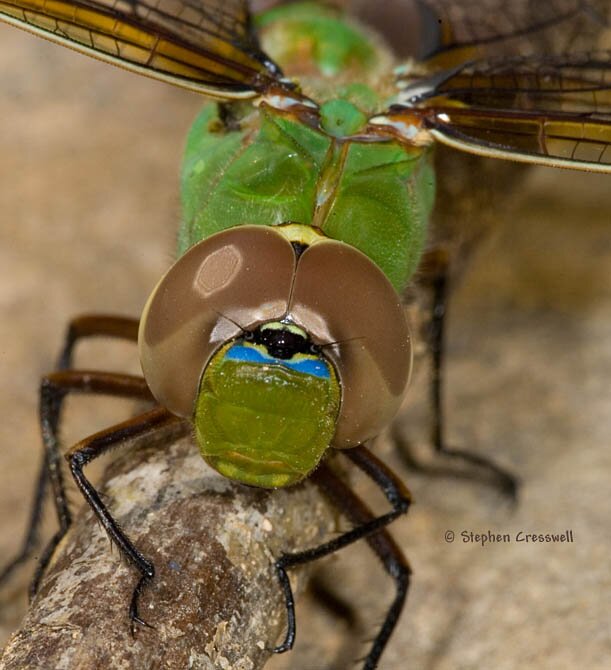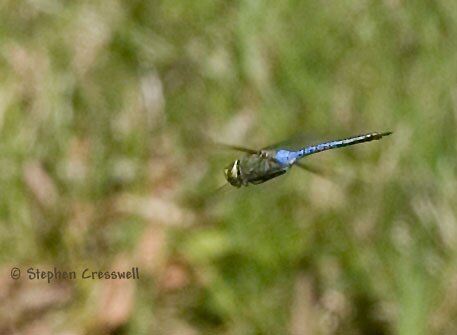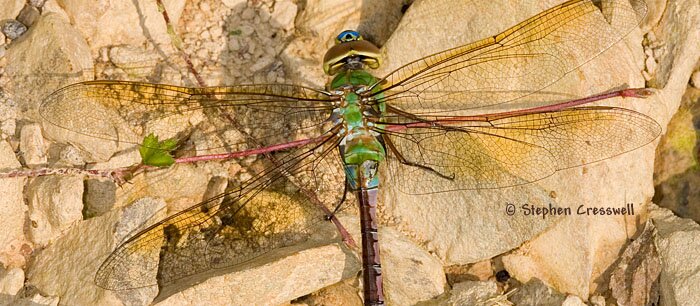

Family: Aeshnidae
Length: typically 70-80 mm
This large, robust dragonfly cannot be confused with any other species in West Virginia or nearby states. The combination of a blue to purple abdomen and a green thorax without markings are unique.
The leading edge of the wings is yellowish, and in fact much of each wing may be amber-tinted.
Males patrol constantly, and you can hear the sound of clashing wings as two males spar with one another.
Egg-laying is usually accomplished with the pair in tandem, which is not true of other Darners. The species shows a preference for fishless ponds, and thus the larvae often become the top predator in the water.
Few West Virginia dragons have a longer flight season. This species may be spotted on warm March days, and is often still on the wing in early November. Common Green Darners are easily seen statewide in West Virginia, and have also been reported from the 48 lower states, Canada and Alaska, the Caribbean, and Central America.
Common Green Darners are sometimes seen in large feeding swarms, and they are also noteworthy for migrating together with the change of the seasons. Autumn brings southward migration for many Common Green Darners; the swarms seem to follow ridge lines or coastal beaches.
The practice of some Anax junius undertaking two-way migrations are unusual in the insect kingdom, and as yet are poorly understood. The migrations are intergenerational, as is true with migratory Monarch butterflies. The darner that flies south dies in the south, and a next generation makes the trip to the north. Some observers have reported migratory swarms of more than a million Common Green Darners, in both Illinois and New Jersey (Freeland et al., 2003).
Still, many Anax junius are not migratory. Some writers have suggested that the migratory and non-migratory individuals could be in different subspecies, or that the migratory individuals inherit the migratory trait genetically. There is scant evidence to back up these notions, though, and it is still unclear by what mechanism some of the Common Green Darners become migratory, and why some do not.
 Right: Note the unmarked green thorax and the yellowish leading edge of the wing. Note, too, this species bulls-eye pattern on the "forehead," a black spot in a yellow background, with a blue area toward the front of the insect. The individual shown is a female, and so has brown eyes instead of green. Her abdomen (seen in the photo at the top of this page) is purple with a dark median line. Males usually have a blue abdomen, though it may darken to purplish in cool temperatures.
Right: Note the unmarked green thorax and the yellowish leading edge of the wing. Note, too, this species bulls-eye pattern on the "forehead," a black spot in a yellow background, with a blue area toward the front of the insect. The individual shown is a female, and so has brown eyes instead of green. Her abdomen (seen in the photo at the top of this page) is purple with a dark median line. Males usually have a blue abdomen, though it may darken to purplish in cool temperatures.
Researchers at Minnesota State University raised the larvae of this species in order to study sex ratios and sex differences in size at emergence. The larvae were fed five phantom midge larvae every other day for a week, then switched to a diet of one a male guppy every other day, and finally back to the midge larvae.
The researchers videotaped individual larvae hunting the guppy, and measured each larvas movement as it hunted. The results indicated that the males were more active hunters, and were larger than the females by their final instar. The sex ratio at emergence was close to 1:1 (Fuselier et al., 2007). The Minnesotans urged further research on the relationship between sex, size, and sex ratios in Dragonflies.


Above: Females in particular often have an amber wash to the wings.
In both males and females, the rear edge of the eyes is yellow.


